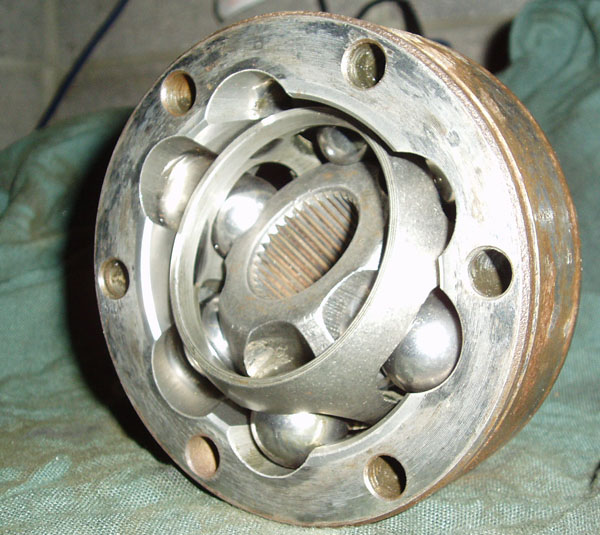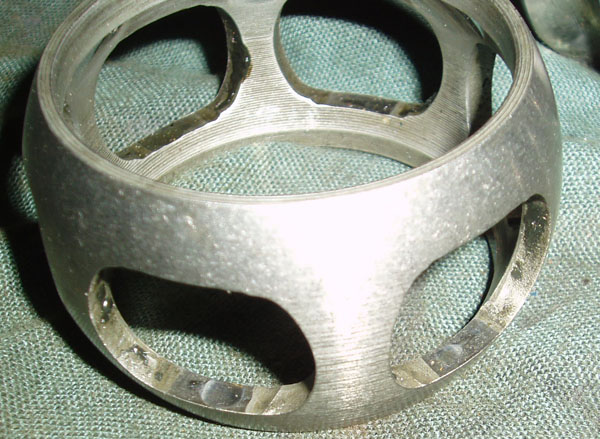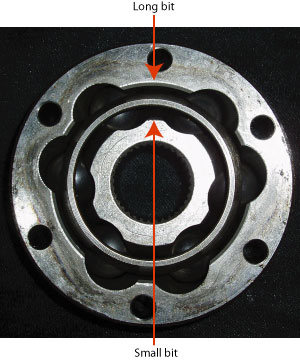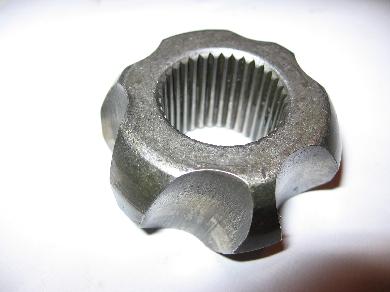Gearbox Clutch CVs CV joints repair: Difference between revisions
No edit summary |
No edit summary |
||
| Line 58: | Line 58: | ||
When rebuilding them you can re-assemble the inner ring and cage and then guide this into the outer ring while at 90 degrees one to the other. Then start feeding the ball bearings in. When you've fed them in turn the unit so it is flat. Now, this bit is important: When you look down on it there are smaller and larger portions that stick in from the outer ring and out from the inner ring - the smaller-sticky-out bits on the inner should line up with the larger sticky-in bits on the outside ring, or the joint won't move out of the flat plane - the cage will rotate around, but the rings will remain locked in place - no good. Here's what it should look like: | When rebuilding them you can re-assemble the inner ring and cage and then guide this into the outer ring while at 90 degrees one to the other. Then start feeding the ball bearings in. When you've fed them in turn the unit so it is flat. Now, this bit is important: When you look down on it there are smaller and larger portions that stick in from the outer ring and out from the inner ring - the smaller-sticky-out bits on the inner should line up with the larger sticky-in bits on the outside ring, or the joint won't move out of the flat plane - the cage will rotate around, but the rings will remain locked in place - no good. Here's what it should look like: | ||
[[Image:CVJ_06.jpg]] | |||
Look at the top of the picture - you can quite clearly see there is a small flat bit that's sticking out of the inner ring and either side there are two larger bits. Got it? Good | Look at the top of the picture - you can quite clearly see there is a small flat bit that's sticking out of the inner ring and either side there are two larger bits. Got it? Good | ||
| Line 72: | Line 72: | ||
Now, I can't answer the question I'm raising without getting out all me greasy manuals and its late, but apart from aligning the large and small sticky out bits, there is supposed to be a right and a wrong way around, axially. | Now, I can't answer the question I'm raising without getting out all me greasy manuals and its late, but apart from aligning the large and small sticky out bits, there is supposed to be a right and a wrong way around, axially. | ||
That is, the faces of the outer and inner races have chamfers on them, different depth chamfers each end and some makes have other markings. Qu. Which way around do all | That is, the faces of the outer and inner races have chamfers on them, different depth chamfers each end and some makes have other markings. Qu. Which way around do all these bits go, and does it matter? | ||
Bentley (and other US articles) makes a big deal about this, and not only which way they go outer to inner, but then which side faces the shaft when installed... all highly friggin confusing I thought, especially as a new GKN one seemed not to agree, chamferwise, with aforesaid dictums. | Bentley (and other US articles) makes a big deal about this, and not only which way they go outer to inner, but then which side faces the shaft when installed... all highly friggin confusing I thought, especially as a new GKN one seemed not to agree, chamferwise, with aforesaid dictums. | ||
Revision as of 13:58, 23 January 2007
Diamond Hell: Constant Velocity joint, otherwise known as CV or CVJ Right, I'm going through a lot of CVs at the moment, cleaning them up and deciding what I'm going to re-use and what I'm not.
There's been at least a couple of topics on here of late about knocking CVs, so let's have a nice clean one apart and we'll see what's making the damned thing knock.
First off, for those who don't have 'orrible hands with black crazy paving all over them, let's just run through the basics of a CV and what it's doing.
These are the things at either end of your driveshafts, that allow drive to be transmitted wherever the wheel is at the time - when the wheel moves up and down the distance between the gearbox and hub changes, so their design allows this difference to be taken up, in addition to this a CVJ allows drive to be transmitted in a constant manner out to the wheel - there's no gearing or trick stuff going on, just constant 1:1 drive out to the wheels.
To create this flexibility what is at the end of the driveshaft is basically an inner and outer ring, both of which have tracks in. In these tracks are basically big ball bearings - these allow the joint to 'float', but they stop the inner and outer rings moving independently - they lock them in place. This locking is assisted by a cage around the bearings to stop them getting out of hand and heading off out of the joint.
Let's have a good poke about with one then:
So, here's what a CVJ looks like when it's off a driveshaft:
You can see I've turned the inner ring so you can see all of the component parts in the first photo.
Here's the opposite view to that - in this you can clearly see the tracks around the outside:
Now, let's have a look at how the tracks are configured to allow the inner and outer races to move around one another:
You'll notice in that picture if you look carefully you can see there appears to be some 'bruising' of the metal - this isn't a new joint, so you can start to see how they break down - think of the raw power of a 1.6D NA tearing through that joint day in, day out - that's what's caused the bruising.
How else do these joints wear? Well in extreme circumstances the retaining cage can break up. This is pretty extreme, shown next is more bruising on the carrier cage for the bearings:
Obviously as this increases the stresses on the thinner parts of the cage become too much and it can break up - this is pretty unlikely and your joint would be making one hell of a racket prior to this (McGill).
The characteristic knocking of worn CV joints is likely to come from more advanced wear than we've looked at so far. To create the knocking what is required is serious breakdown of the bearing surfaces (and potentially the bearings). Here's a photo that explains what your knocking might be caused by:
As you can see, there's substantial breakdown in the surface, with big pits creating places the bearings can fall into, clicking as they move around in the holes in their surface. When a joint gets to this condition there's going to be a lot more shock loading on the bearings as they fall in and out of the pits - this will accelerate the wear in the joint. Wear similar to that pictured isn't necessarily going to have been caused just by shocks in every day use, it may well be that there's been a tear in the CVJ boot that keeps out all the filth - as soon as grit and muck gets in the joint it creates a grinding paste that will accelerate wear further.
Wear and knocking can still be caused if the boot is intact, as over years the grease in the joint will degrade and dry out, reducing lubrication and increasing wear. Due to this it makes sense to strip the joints down occasionally and clean and re-grease them. This will keep everything moving nice and smoothly and keep those nasty knocks at bay.
So, if you pull your driveshaft to bits and find this sort of nasty wearthen you should probably replace the CV. Although if you look at the wear patterns you can see that if you swap the driveshafts over then it's possible you may be able to almost double their life.
They're not too difficult to do (especially if you've got a press ;)) and if they're knocking then at £20ish per joint from your favoured auto-factor it's worth taking the time to swap them out.
If you see a torn or perished boot this is also well worth replacing, although you should clean out as much muck as possible (preferably taking the joint to pieces) otherwise you're just putting fresh grinding paste back in.
If you choose to strip and rebuild then it's important to note that the joints are manufactured PAIRED, so keep the same outer and inner rings with one another.
When you take them apart all you need to do is gently twist the inner ring through almost 90 degrees and then gently push out the ball bearings, now turn it back and open out on another axis, after you've done 3 or 4 of them you'll find the inner ring will probably drop out with the retaining cage around it. The inner ring can be gently 'rolled' out of the cage to separate these components.
When rebuilding them you can re-assemble the inner ring and cage and then guide this into the outer ring while at 90 degrees one to the other. Then start feeding the ball bearings in. When you've fed them in turn the unit so it is flat. Now, this bit is important: When you look down on it there are smaller and larger portions that stick in from the outer ring and out from the inner ring - the smaller-sticky-out bits on the inner should line up with the larger sticky-in bits on the outside ring, or the joint won't move out of the flat plane - the cage will rotate around, but the rings will remain locked in place - no good. Here's what it should look like:
Look at the top of the picture - you can quite clearly see there is a small flat bit that's sticking out of the inner ring and either side there are two larger bits. Got it? Good
Once you're got the joint back together, make sure you put the boots on the drive shaft FIRST or you'll be taking the joints back off! To replace the joints first make sure the splines on the shaft are lined up - if you gently rotate the joint around the top of the shaft you'll feel them jump over one another and then fall in. Line them up carefully, or you could damage the driveshaft!
When you've lined up the splines the shaft should engage and start moving into the joint. You might like to get a nice clean bit of wood to protect the joint from your hammer. If it's not too big you'll be able to use it as a punch to knock the joint down the last bit of the shaft so you can replace the circlip on the end. Clamp the metal ring around the end of the boot when it's seated in the groove in the driveshaft and pull the metal housing down over the joint and you're ready to do the other end - it's just the same.
If anyone else has anything they want to add, or correct on this post then please do - I hope this has been of interest and possibly even some use to people
HarryMann:
Now, I can't answer the question I'm raising without getting out all me greasy manuals and its late, but apart from aligning the large and small sticky out bits, there is supposed to be a right and a wrong way around, axially.
That is, the faces of the outer and inner races have chamfers on them, different depth chamfers each end and some makes have other markings. Qu. Which way around do all these bits go, and does it matter?
Bentley (and other US articles) makes a big deal about this, and not only which way they go outer to inner, but then which side faces the shaft when installed... all highly friggin confusing I thought, especially as a new GKN one seemed not to agree, chamferwise, with aforesaid dictums. Having played Rubik's cube with it for quite long enough (pre-greasing up being the best time Idea ), settled for the way that it seemed to offer least resistance and jamming up at large angles. As for putting on the truck, think the circlip goes the least chamfered side of the inner race.
Will dig out the manuals unless soemone knows the 'real way', 'right way' or indeed that it doesn't matter a jot for some makes, that it does for OEM joints, or vice versa... (I'm sure that's enough options Rolling Eyes )
90gms of the black stuff per joint? Just stuffing it inside the boot no good - roughly half from each side and really work into the cage. When they're just starting to clunk a bit, to give them another lease of life, or just 'cos you fancy it, squeeze the filthy boot around to work the grease back into the joint - silence - for a while. Clunking rear CVJs can upset smooth changing in lower gears, and put additional shock loads through the diff too.
A full service is: wash off and degrease, clean off all traces inspect, decide, significant track pitting/ galling a no-no, just wear but smooth tracks - OK if you're a tight-wad Reassemble - 'tis fun, honest - refit, regrease.
HarryMann: Yup, I was led to believe that articulation angle is compromised by assembling the wrong way around.
Grease: ETKA says repair kits include 90g (14" rear) and 120g (16" rear) joints I can get all 90g in, and again, led to believe that it's a good idea to put it all in. GSF do a big pot of 'medium' MOS2 cheap, but reckon they'd give you another sachet if asked nicely. If it was a repair kit, maybe 50g is meant not to service, but to top-up - or meant to have two sachets in - one for each side of joint. As with wheel bearings, perhaps never fill cavity 100% (overheat, melty grease) but that would be as good as impossible with a booted joint. Release trapped air through boot sleeve before crimping up tight, but don't leave boot crushed,
SyncroSam: Clive, Is this the difference in chamfer you are referring to?
Top pic smoother edge, bottom pic sharper edge) - I thought sharp edge was driveshaft end as in goes on shaft first, but i probably wrong
TD: very interesting and great pictures, but I just throw them away when they knock and buy new ones, they are a cheap item compared to many things and outers last 70K +, inners much longer. They are the dirtiest, foulest things to take apart, even paraffin has a job to clean them.Still, makes a grat hobby
Flibbertigibbet: but I would like to point out to the more ignorant amongst us what is sounds like is they need changing....ready -
Like a clucking chicken .....!!!!







